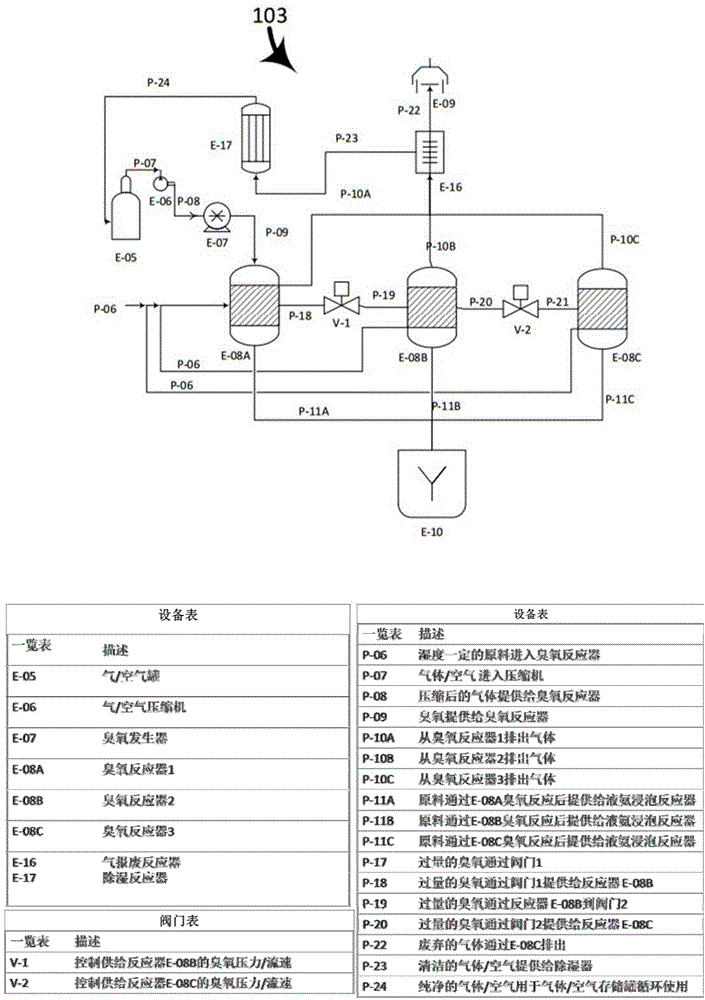Advanced methods for sugar production from lignocellulosic biomass and fermenting sugars to microbial lipids
A technology of lignocellulose and raw materials, applied in the field of microbial oils
- Summary
- Abstract
- Description
- Claims
- Application Information
AI Technical Summary
Problems solved by technology
Method used
Image
Examples
Embodiment 1
[0118] Analysis of Sugars in Wheat Grass Treated with Controlled Ozone and Ammonia Soaking (SAA) Treatments and a Combination of Both (Ozone Treatment followed by Ammonia Soaking Treatment)
[0119] To contrast and through 2 hours ozone treatment (state: (ozonation: 90% humidity is adjusted to 42-60 mesh particle diameter, 5.4% ozone reacts 2 hours under the air flow of 2 liters / min), only ammonia immersion handles (condition 60 ℃ and 24 hours), combined treatment (ozonation: 90% humidity is adjusted to 42-60 mesh particle size, 5.4% ozone reacts 10 minutes under the air flow of 2 liters / minute; Ammonia soaking: 20% solid content (w / v), 20% ammonium hydroxide aqueous solution (w / v), 50 ℃ of reaction temperature and the reaction time of 6 hours) the sugar analysis result of the rice straw sample is shown in table 1.The concentration of monosaccharide in the sample after ozone treatment The concentration decreases with time, which may be related to the reaction of ozone with su...
Embodiment 2
[0124] Effect of Ozone Pretreatment on Sugar Recovery of Wheat Straw Particle Size
[0125] Wheat straw particle size (42-60 mesh) was adjusted to a moisture content of 90% (W / W), and was heated at room temperature (23°C) with an ozone-enriched oxygen stream (oxygen flow rate 2 liters / min) containing 5.4% ozone. , React in a stainless steel reactor for 5 to 30 minutes. The treated biological raw material is taken out and saccharified according to the following procedure. The wheat straw residue (0.2 g) obtained from the above procedure was added to 20 ml of citrate buffer (pH=4.8) while adding 1.5 L (71.0 μL, protein concentration = 126.5 mg / mL) and Novozym 188 (14.0 μL, protein concentration = 134 mg / mL) enzyme mixture, and the mixture stayed on the shaker at 50°C for stirring. Samples were taken after 72 hours, enzymes were inactivated by boiling water for 5 minutes, and sugar concentrations were analyzed by Diane ion chromatography. The results are shown in Table 2. Th...
Embodiment 3
[0130] Effect of superoxide water treatment on enzymatic hydrolysis of wheat straw granules
[0131] 3 grams of wheat straw particles (42-60 mesh) are thoroughly mixed with water containing hydrogen peroxide (the molar ratio of hydrogen peroxide and ozone provided by concentration adjustment is 1:2) and adjusted to a moisture content of 90% (W / W). The mixture was placed in a stainless steel autoclave and generated highly reactive hydroxyl radicals at room temperature (23° C.) for 5 to 30 minutes with an ozone-enriched oxygen stream (oxygen flow rate 2 L / min) containing 5.4% ozone. The treated biological raw material is taken out and saccharified according to the following procedure. The wheat straw residue (0.2 g) obtained from the above procedure was added to 20 ml of citrate buffer (pH=4.8) while adding 1.5 L (71.0 μL, protein concentration = 126.5 mg / mL) and Novozym 188 (14.0 μL, protein concentration = 134 mg / mL) enzyme mixture, and the mixture stayed on the shaker at 50...
PUM
 Login to View More
Login to View More Abstract
Description
Claims
Application Information
 Login to View More
Login to View More - R&D
- Intellectual Property
- Life Sciences
- Materials
- Tech Scout
- Unparalleled Data Quality
- Higher Quality Content
- 60% Fewer Hallucinations
Browse by: Latest US Patents, China's latest patents, Technical Efficacy Thesaurus, Application Domain, Technology Topic, Popular Technical Reports.
© 2025 PatSnap. All rights reserved.Legal|Privacy policy|Modern Slavery Act Transparency Statement|Sitemap|About US| Contact US: help@patsnap.com



